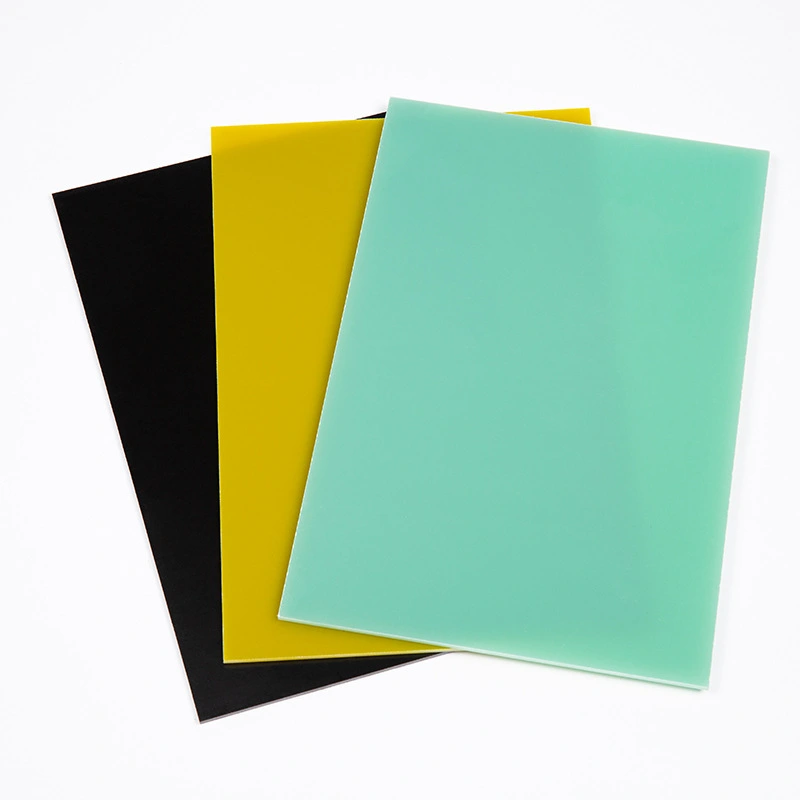Properties and Composition of G10 Fiberglass Sheet
Chemical Composition and Manufacturing Process
G10 fiberglass sheet is produced by combining woven glass fiber cloth with epoxy resin to create a strong, durable composite. During manufacturing, multiple layers of glass fabric are thoroughly impregnated with epoxy resin under controlled temperature and high pressure, ensuring full saturation and adhesion between layers. This lamination process results in a dense, uniform sheet with minimal voids or imperfections. The combination of strong glass fibers and a thermosetting epoxy matrix gives G10 its superior mechanical integrity, electrical insulation, and chemical resistance properties.
Physical and Mechanical Properties
G10 fiberglass sheet exhibits outstanding physical and mechanical characteristics essential for demanding applications. Its high tensile and compressive strength allow it to withstand mechanical loads and impacts without cracking or breaking. Additionally, its low moisture absorption prevents swelling or dimensional changes in humid environments, ensuring structural stability. The excellent dimensional stability of G10 is maintained across a wide temperature range, preventing warping or deformation. These properties make it a reliable choice for structural components, insulating parts, and precision-engineered applications in various industries.
Electrical Insulation Capabilities
G10 fiberglass sheet is renowned for its exceptional electrical insulation performance, making it indispensable in electronic and electrical applications. It offers high dielectric strength, enabling it to resist electrical breakdown even under high-voltage conditions. Its low dielectric loss ensures minimal energy dissipation, maintaining signal integrity in electronic circuits. This combination of electrical properties makes G10 sheets ideal for insulating circuit boards, switchgear components, and transformer parts where reliable electrical isolation and safety are critical for operational performance and equipment protection.
Applications of G10 Fiberglass Sheet in the Electrical and Electronic Industry
Printed Circuit Boards (PCBs)
G10 fiberglass sheet is widely used as a substrate material for printed circuit boards due to its excellent dimensional stability, electrical insulation, and mechanical strength. Its flat, rigid surface provides an ideal base for copper cladding, enabling precise circuit etching and reliable electrical pathways. G10’s resistance to thermal expansion and high temperatures ensures it maintains structural integrity during soldering and reflow processes. These properties make it a preferred material in the production of single-layer and multi-layer PCBs for various electronic devices and industrial control systems.
Electrical Insulators and Standoffs
In electrical installations, G10 fiberglass sheet is frequently fabricated into insulators, standoffs, and spacers that maintain separation between live components and grounded structures. Its high dielectric strength prevents electrical arcing, while its mechanical durability withstands compressive and tensile stresses during equipment operation. These components ensure electrical safety, stability, and reliable performance in switchgear assemblies, circuit breakers, and power distribution panels. Additionally, G10’s moisture resistance and thermal stability make it suitable for use in diverse environments, including high-humidity or temperature-variable conditions.
Transformer and Motor Components
G10 fiberglass sheet is extensively utilized in transformers and electric motors due to its combination of mechanical strength, electrical insulation, and thermal resistance. It is commonly machined into components such as end rings, slot liners, insulating cylinders, and phase barriers. These parts help maintain coil integrity, prevent short circuits between windings, and provide structural support under operational stresses. The material’s ability to endure continuous exposure to heat and electrical fields ensures the long-term reliability, efficiency, and safety of transformers, generators, and various industrial motors in demanding applications.
Advantages of G10 Fiberglass Sheet Over Alternative Materials
Comparison with Other Insulating Materials
Compared to other insulating materials such as phenolic resins, ceramics, or thermoplastics, G10 fiberglass sheet provides an optimal combination of electrical, mechanical, and thermal properties. While ceramics offer high temperature resistance, they are brittle and lack mechanical flexibility. Phenolic laminates, though cost-effective, often have lower electrical performance and moisture resistance. In contrast, G10 maintains high dielectric strength, mechanical durability, and dimensional stability under varying conditions, making it a versatile material for applications demanding both electrical insulation and structural integrity.
Cost-Effectiveness and Longevity
Although G10 fiberglass sheet may initially cost more than certain alternatives, its long-term economic benefits outweigh upfront expenses. Its robust mechanical properties and resistance to thermal, electrical, and environmental degradation ensure components made from G10 have extended operational lifespans. Reduced failure rates and minimal maintenance requirements lower replacement costs and system downtime. This reliability and longevity make G10 a cost-effective choice for manufacturers and users aiming to maximize efficiency, reduce maintenance budgets, and ensure operational stability in critical electrical and mechanical applications.
Environmental Considerations
With increasing focus on sustainability, G10 fiberglass sheet offers environmental benefits through its durability and long service life, reducing waste from frequent replacements. Its stable performance limits resource consumption in maintenance and manufacturing processes. Furthermore, advancements in epoxy resin technology are leading towards more eco-friendly formulations with lower environmental impact. Research into recycling composite materials is also underway, potentially enabling reclaimed fibers or resin reuse. These initiatives enhance the overall environmental profile of G10 fiberglass sheet, aligning with modern industry sustainability goals and regulatory compliance requirements.
Conclusion
The widespread adoption of G10 fiberglass sheet in the electrical and electronic industry is a testament to its exceptional properties and versatility. Its unique combination of electrical insulation, mechanical strength, and thermal stability makes it an indispensable material in numerous applications. From serving as the foundation for complex circuit boards to providing critical insulation in high-voltage systems, G10 fiberglass sheet continues to play a pivotal role in advancing electrical and electronic technologies. As the industry evolves, this remarkable material is likely to remain at the forefront, adapting to new challenges and enabling innovative solutions.
Contact Us
For more information about our G10 fiberglass sheet products and how they can benefit your electrical and electronic applications, please don't hesitate to contact us at info@jhd-material.com. Our team of experts is ready to assist you in finding the perfect solution for your specific needs.






